Category Archive for Food + Theme Restaurants
Casa de Campo resort review: our luxurious Dominican Republic hotel! La Romana all-inclusive, restaurants.
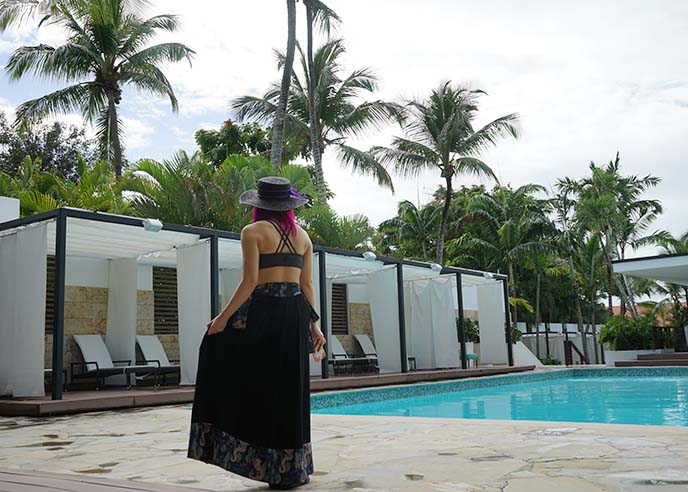
Winter… what’s that? In early January, I escaped the cold by travelling to Casa de Campo Resort & Villas in the Dominican Republic!
With 7000 acres of palm trees, warm beaches, a marina, golf courses and activities — it’s easy to see why Casa de Campo is one of the Leading Hotels of the World.
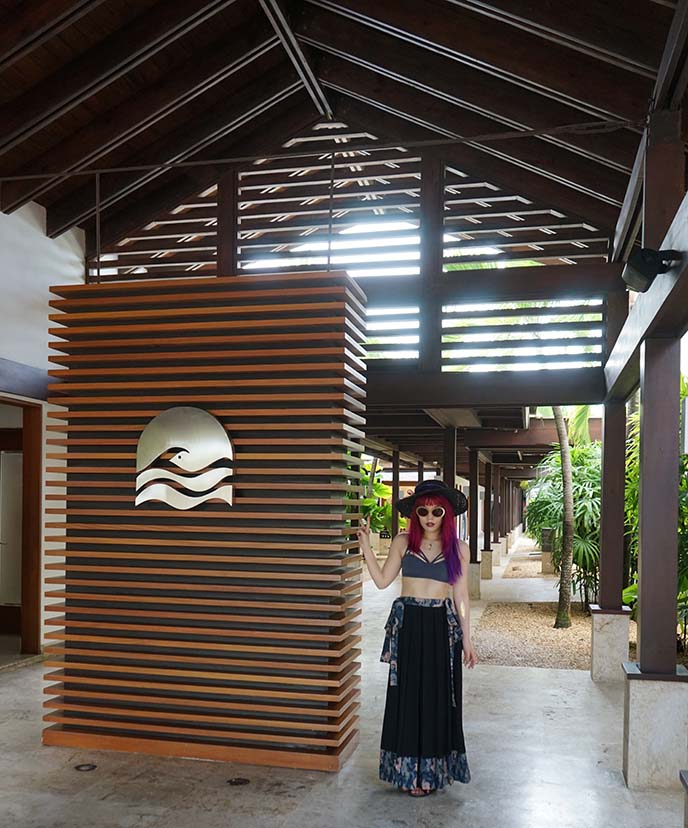
My photographer and long-time friend Molly Weingart accompanied me to the Dominican Republic. We wanted to be surprised, so we didn’t do much research beforehand… and our jaws dropped when we saw this exquisite property. Casa de Campo isn’t your typical all-inclusive; it’s the most beautiful and luxurious resort on the island.
(Outfit details: I’m wearing this exact Sunnydip black straw boater hat by Lack of Color. My skirt is h.NAOTO, and bra is Cyberdog.)

How to get here: Casa de Campo is a resort and community located in La Romana, on the southeast coast of the DR. Most international flights land at Punta Cana or Santo Domingo airport. From there, you can either take another short flight to La Romana airport, or have the hotel pick you up (the drive is about an hour long).
Casa de Campo address: Carretera La Romana – Higuey, La Romana 22000, Dominican Republic
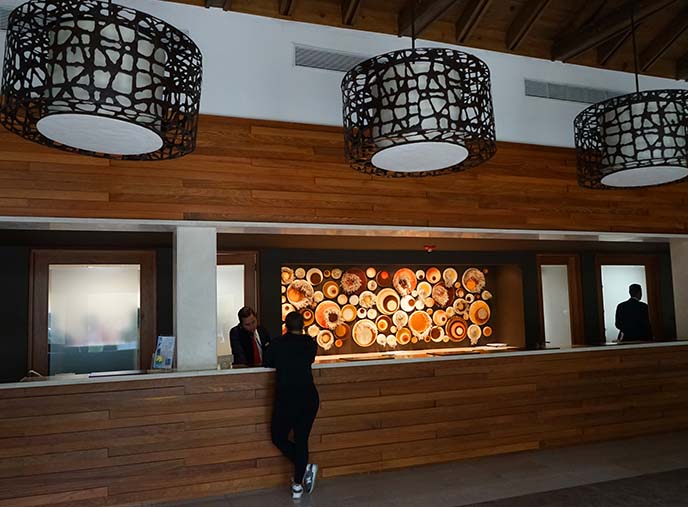
Casa de Campo was established in 1974, but recent renovations have modernized the buildings with an airy, warm Caribbean feel.
From the moment we arrived, we were in love with the peaceful, authentic feeling of this five-star resort. There’s nothing “touristy” or “Americanized” about the experience. Molly instantly bonded with the staff, who chatted with her in Spanish, and were always a step ahead of our needs.
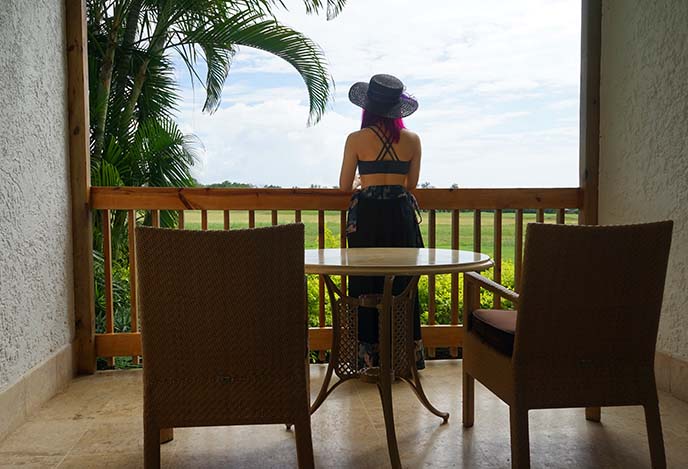
Casa de Campo has a variety of rooms to choose from. Our home base was this spacious suite, with our own patio overlooking the tropical grounds.
(CDC has private villas for rent too. In the next post, we’ll give you a glimpse of this rock-star living.)
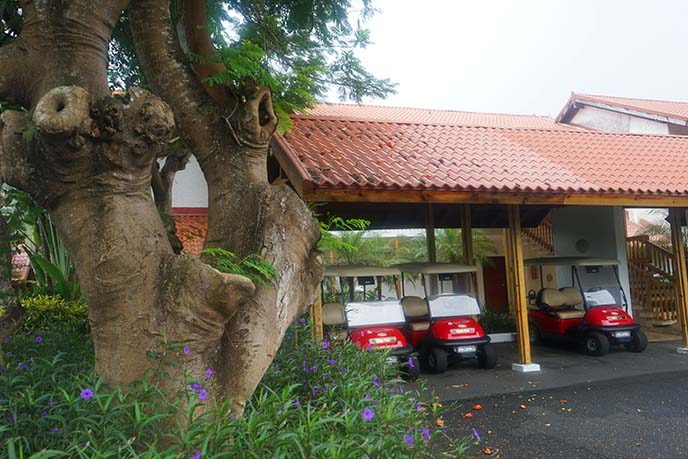
As a “Mario Kart” fan, I was tickled to learn that every guest received a personal golf cart! Molly and I had our own little 4-passenger mini car, marked with our room number. This way, we could easily get from place to place (remember, the grounds span thousands of acres).
The carts also make sense because Casa de Campo is hands-down the best golf resort in the country, with three award-winning Pete Dye courses including “Teeth of the Dog.”

It was quite the adventure to learn how to put the golf cart in reverse, turn on the lights, and avoid oncoming traffic. For the safety of everyone on the resort, I let Molly do the driving!
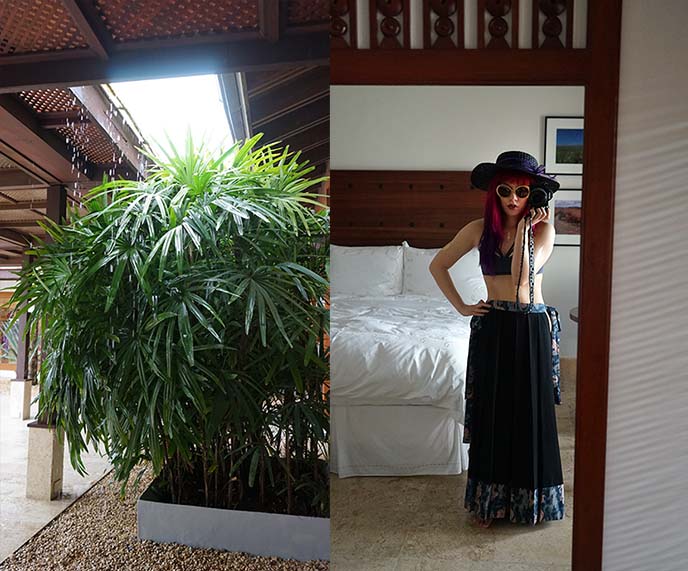
We went to the Dominican Republic in January, the pleasantly warm and dry season. The east coast storm brought brief rainshowers, but these let up quickly by the afternoons.
Even if it’s raining, there’s plenty to do indoors. Our comfortable room had fast wifi, a flat screen TV, and giant bathroom with a separate dressing room. I loved spending time soaking in the bathtub, which came with L’Occitane bath products including an effervescent cube.
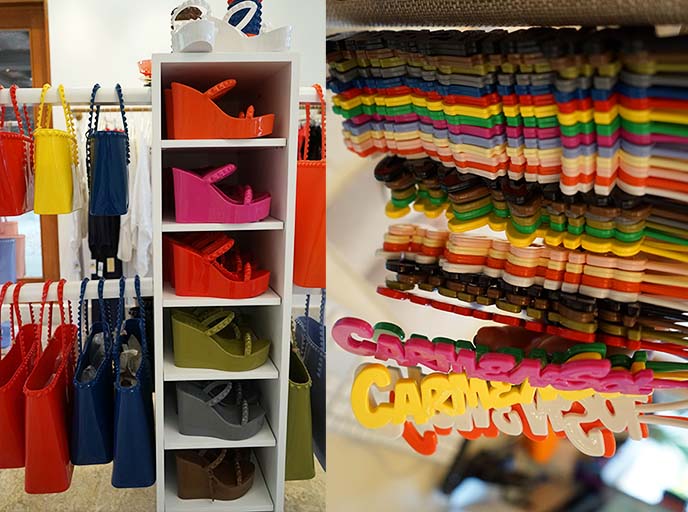
There’s also the option of going shopping. Casa de Campo’s lobby opens up into a courtyard with several fashion boutiques. We loved the colorful selection of designer resort wear, and were tempted to get jelly spiked platform shoes by Carmen Sol. (She also makes the studded sandals below.)
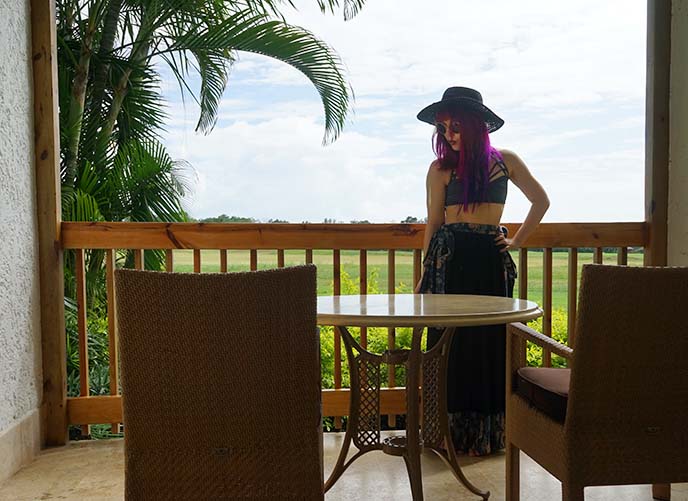
Here’s another look at my “tropical Goth” outfit, perfect for a relaxing getaway in the Caribbean.
I’m wearing this black straw sunhat by Lack of Color Australia. My long Japanese skirt is h.NAOTO, and bra is Cyberdog.
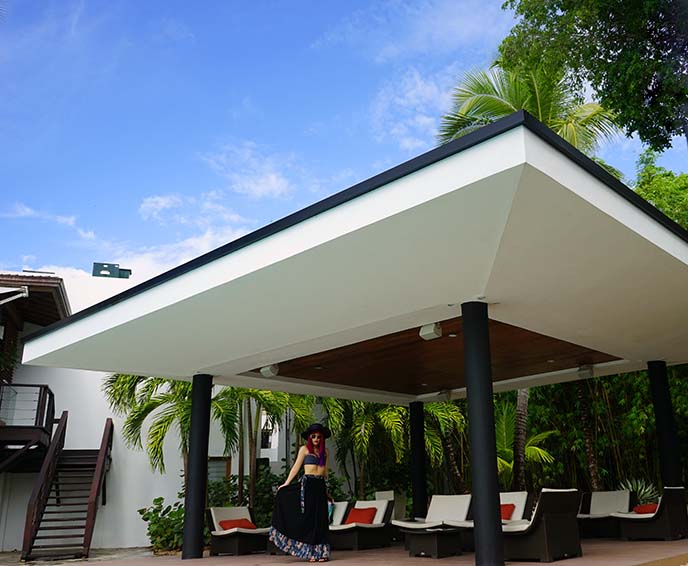
The sun is out — time to explore! Casa de Campo’s all inclusive package is a stellar deal, especially if you’re a foodie and enjoy trying new activities.
With this package, guests get full unlimited access to the amenities including the swimming pools, fitness center, bars, and seven restaurants. You also get to experience horseback riding, skeet shooting, tennis and water sports (we’ll show you the fun we had, in the next post!)
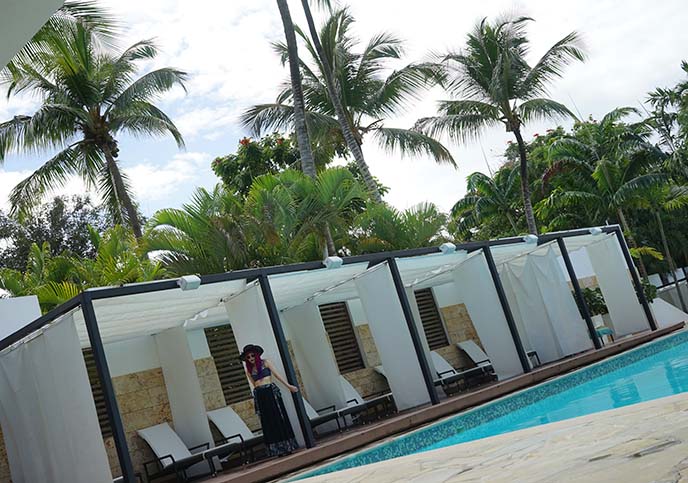
Can’t go wrong with the main pool deck, featuring modern cabanas and an in-water bar. The resort’s guests were very respectful (you won’t encounter rowdy guys or noisy children), and you can always find a secluded spot to lounge.
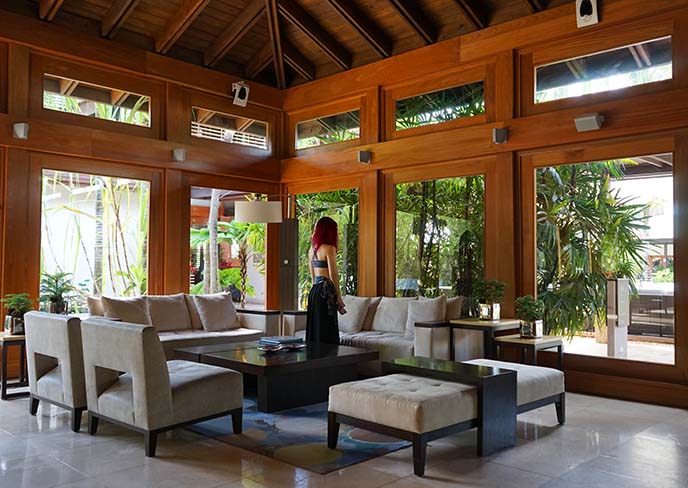
Casa de Campo’s common areas are also beautifully designed. High ceilings, rich mahogany and native stone create a relaxing tropical vibe.
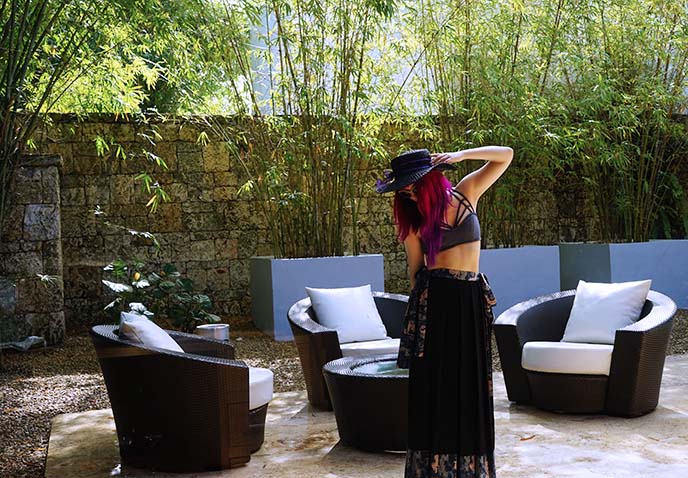
So many lounge areas to choose from! But first, a cocktail please.
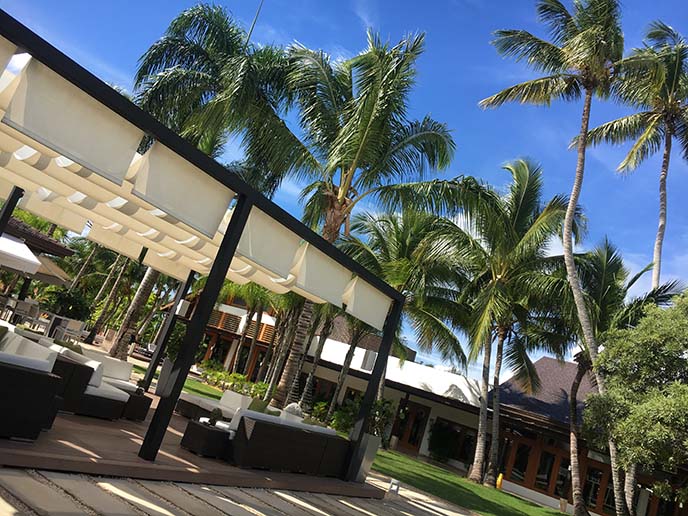
The bar at La Caña is located in the main area of the resort, with both indoor and outdoor seating. The friendly bartenders quickly get to know you by name, and prepare your favorite drink with a generous pour.

La Cana bar is a popular gathering spot for guests, who come to watch the game on the big screen, dance to live music, or simply hang out on the L-shaped couches. Molly and I would often come here to grab a snack or drink, and chat with our favorite bartenders.

The Dominican Republic is known for its fruit and rum (Brugal, Barcelo, and Bermudez are local favorites). I combined these in the perfect tropical drink: freshly blended pineapple juice, with Ron Bermudez Aniversario dark rum! I also recommend their special “Coco Chanel” cocktail, a scrumptious mix of coconut puree, lime juice, white rum and black pepper.
On the right: the bartenders also brew up an addictive latte with perfect froth, served with home-baked cookies.

Unlike typical resorts, the dining at Casa de Campo is at a consistent high level. I got my “fish fix” at La Cana restaurant, and ordered Nicoise salad, grouper, and sea bass. All were prepared beautifully with Mediterranean flair.
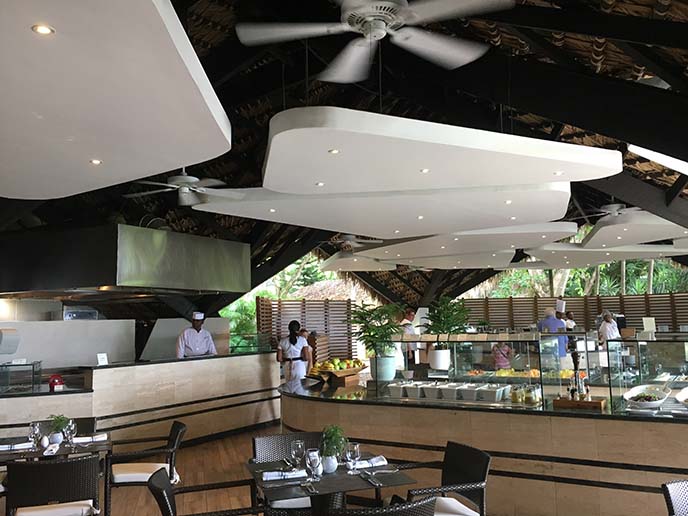
I’m usually not a fan of buffets. However, once again, Casa de Campo reversed my expectations. Lago Restaurant served up probably the best lunch buffet I’ve ever had, with dozens of Dominican dishes to choose from.

You could have mahi mahi, chicken, and steak grilled up fresh — or choose from these bright Caribbean salads. Or try a bit of everything, as I did. The creamed pumpkin, sweet potato mash, coconut fish, and roast chicken… I’m still thinking of this meal today!
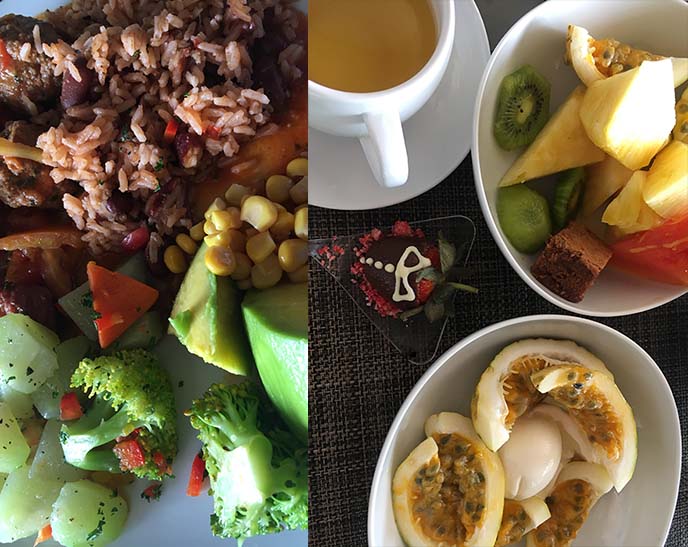
On the left, a snap of my pigeon beans and rice, chayote, avocado, and grill selections. We ended with tea and a selection of fruit and desserts; as you can see, I have a passion for passionfruit.
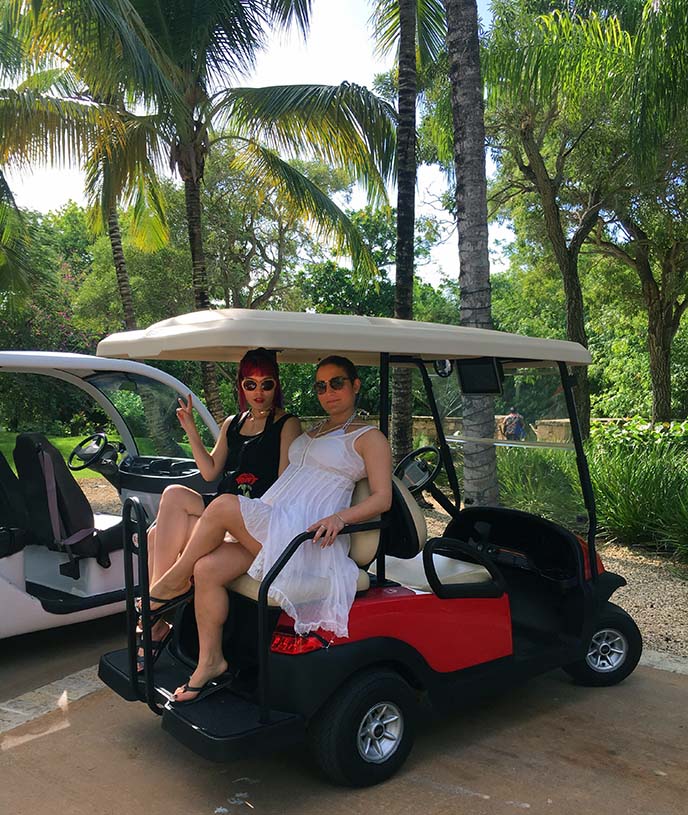
Too stuffed to drive? Thankfully, the hotel bellmen can give you a lift any time. We discovered it’s especially fun to ride on the backseat of a golf cart when you’re a little tipsy!

We carted to the resort’s newest addition, Minitas Beach Club. It’s located right by the ocean, and features an open-air bar with minimal lines.

Molly and I immediately took off our shoes to wade in the 23 meter infinity pool. I love the modern, upscale design of the pool deck and lounge areas.

Minitas Beach Club also encompasses a casual oceanside restaurant. We sat down to panoramic views of the sand and waves, and sipped on rum with coconut cream. (Don’t you feel relaxed, just looking at this?)

Minitas Beach Club Restaurant has a menu inspired by Mediterranean and Latin American cuisines. To match this casual beachfront, there’s an extensive selection of fish served light, clean and bright — as well as a selection of vegan and gluten-free options.

We dined on arepas, fried plantains, ceviche, and burrata. A pleasure to listen to the sounds of the ocean, while dining on colorful salads and vegetable dishes.

As you can see, there are so many different areas to explore in Casa de Campo. The community also includes The Marina, where you’ll find multi-million dollar yachts bobbing in the water. It’s a charming area with art galleries, boutiques and restaurants amidst cobblestone paths.
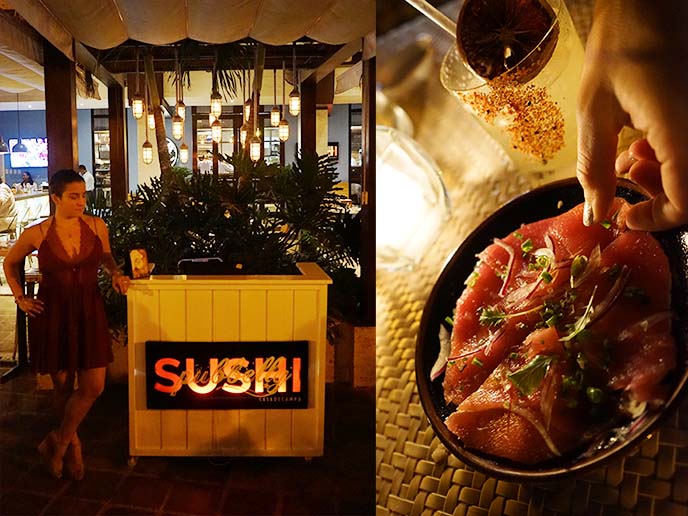
After window-shopping at The Marina, we went to Pubbelly Sushi for what Molly calls the best sushi of her life. (She’s planning to visit Miami, just so she can eat at their original location!) She says, “I thought they did a great job of respecting traditional dishes while playing with the creativity allowed in modern cuisine” — and I wholeheartedly agree.
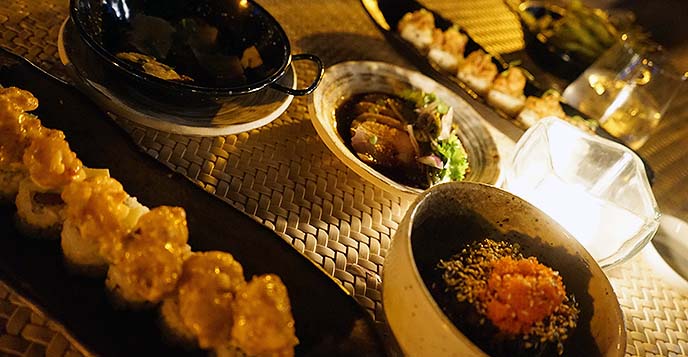
Our waiter, Cezar, suggested innovative dishes such as the Tuna Pizza (with crispy tortilla, garlic aioli, and truffle oil), short ribs gyoza, and Tigueraso sushi (shrimp tempura, spicy tuna, avocado). We were delighted by unexpected combinations like dates with chorizo, and brussel sprouts with miso.
Be sure to order the unique cocktails, made with Japanese spirits like umeshu, sake framboise and vodka-sake. And leave room for the berries and cream dessert of dreams.

We walked off the meal with a stroll in the Marina, and came across this metal statue. Molly’s red dress made her the perfect dance partner for the bull.

On another evening, we revisited The Marina to dine at La Casita, a Spanish fine dining establishment. (As you’ll recall, all these stunning restaurants are part of the Casa de Campo all-inclusive pack. The concierges are great at making reservations for all their guests.)

Casa de Campo is an elegant resort, and it inspired us to dress the part. We noticed that guests tend to be from European or Spanish-speaking countries, and are very stylish (I saw some beautiful jewelry, handbags and resort-wear!)
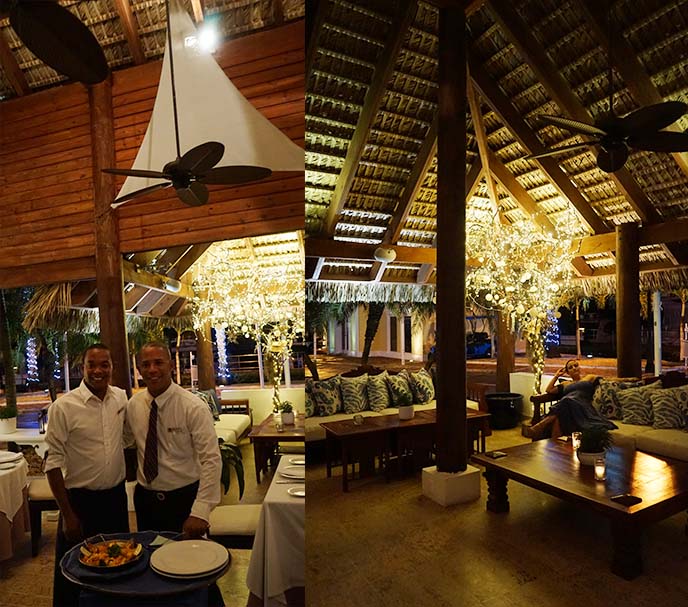
At La Casita, we ordered passionfruit rum cocktails, followed by sangria with fresh fruit. What a treat to sip these drinks under tall sail-like callings, while yachts pass by in background.

It was easy to choose our main course: seafood paella. The servers plated this beautiful mix of Spanish saffron rice and seafood at our table, and we finished up every last grain.

As we dined al-fresco, we got a visit from some furry friends. It looks like the cats want a piece of shrimp!
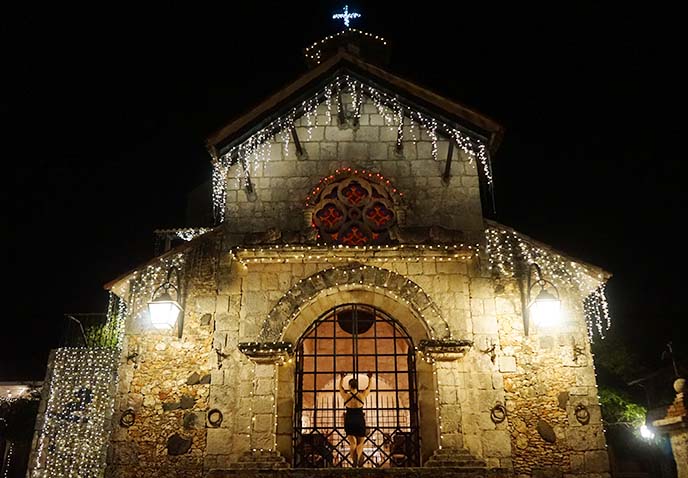
Finally, we rode our golf carts to Altos de Chavón, and found ourselves in a re-created 16th century Mediterranean village. This project as conceived by Dominican architect, Jose Antonio Caro, and Italian designer / cinematographer Roberto Coppa.
The quaint village includes a 5000-seat Grecian-style amphitheater that has held performances by Andrea Bocelli, Julio Iglesias, Sting and Carlos Santana.

Altos de Chavón is a cultural center that lets guests meet artists from all over the world. In the daytime, you can pop into studios dedicated to pottery, weaving, silk screening and other media. The village is also home to the Altos de Chavón School of Design, which is affiliated with Parsons in New York.
At night, St. Stanislaus Church glows next to sweeping views of Chavón River.

Since Altos de Chavón has a Mediterranean feel, it was fitting that we had dinner at this rustic Italian restaurant, La Piazzetta.

We entered what looked like a home in the Italian countryside, lit with candles. This sweet trio serenaded us with traditional songs, while we eyed the antipasti bar and handmade pastas.

Red wine, creamy black truffle risotto, and green pea ravioli with Parmesan… what else does one need in life? La Piazzetta’s flavors are as lovely as anything I’ve had in Italy; in fact, this was the best pasta and risotto I’ve had in a while.

We continued with filet mignon and truffles, and melt-in-your-mouth tiramisu. Trust us, Casa de Campo’s dining is outstanding and will satisfy even the most jaded foodie.

Back to La Cana bar for a nightcap, and some dancing! Every night, Casa de Campo brings in live music to the lounge. Singer Daniel Castro Arias showed us how to dance the bachata (a style of dance from the Dominican Republic).

The atmosphere got lively as more guests took to the dance floor. We watched them sing their hearts out to Toño Rosario – Dale Vieja Dale, while hopping back and forth — a memory that will always make us smile!

Casa de Campo was the perfect winter getaway to the Dominican Republic. The resort exceeded our expectations in every way, with world-class food and amenities in a picture-perfect setting. Now that I’m back in cold weather, I’m keen to return to the tropics as soon as I can.
PS: this is only Part 1 of our Caribbean adventures; stay tuned for the next story featuring the beaches and activities.
SHARE & COMMENT
Twin Peaks themed bar & restaurant, The Black Lodge Vancouver! Strathberry East/West crossbody handbag.
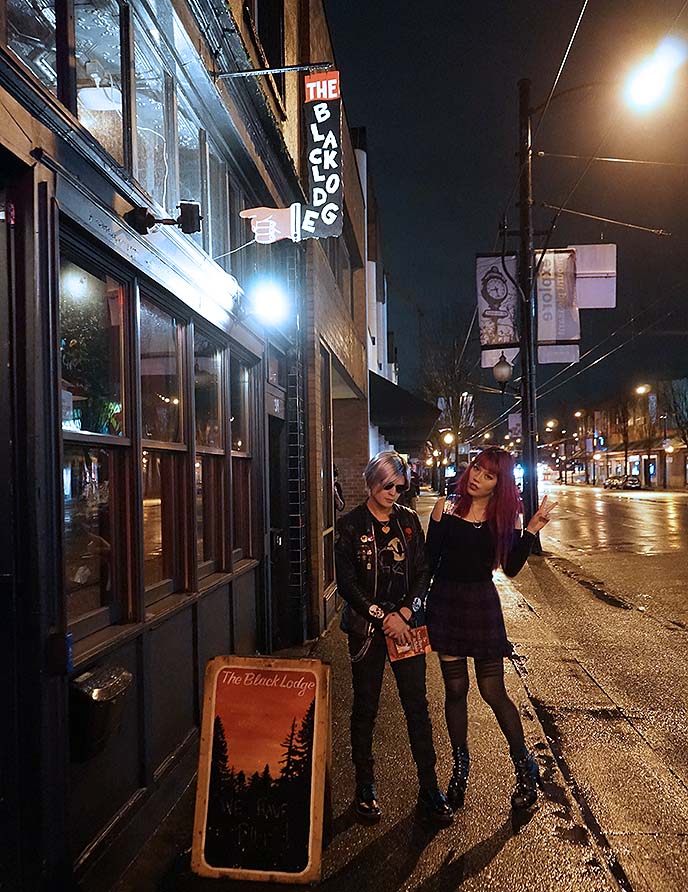
Twin Peaks fans, this one’s for you. Did you know there’s a restaurant and bar in Vancouver… inspired by David Lynch’s cult TV series?
It’s called The Black Lodge, and as you’ll see, it deserves a whole lot of thumbs up.
Read on for photos of inside the Twin Peaks theme restaurant including a Red Room, cocktails named after show characters, and of course — damn fine coffee with cherry pie.

Since many of you loved my Instagram preview, I’ll also unveil my new East/West crossbody beauty from Strathberry. They’re my favorite handbag designer for obvious reasons: clean, minimal, handcrafted perfection! More about these purses below:
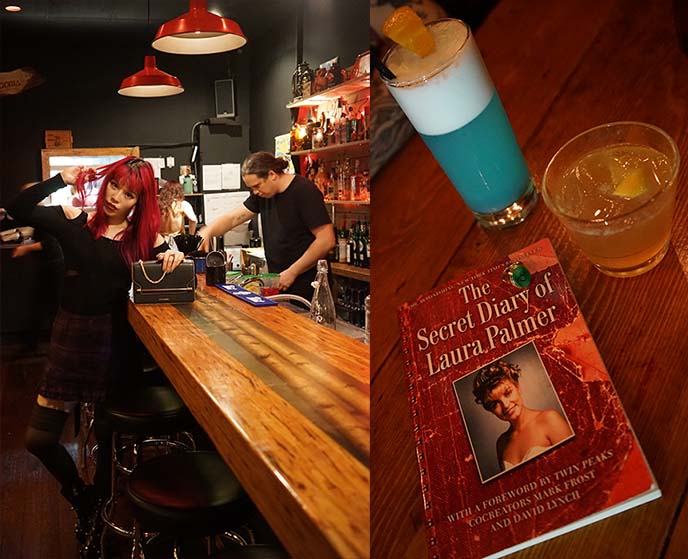
The Black Lodge has been a hidden gem in my hometown (Vancouver) for some time. After the success of their first location, the owners set up a second, larger restaurant on Broadway near Main Street, which I visited on David Lynch’s birthday.
My friends and I are fans of Twin Peaks, the 1990-1991 mystery TV series that returned for a season last year. It’s a favorite among Goth / horror fans, and one of director Lynch’s most celebrated works. The plot opens with the murder of homecoming queen Laura Palmer, and spirals into an addictive web of camp, surrealism, drama and the supernatural.
Broadway Black Lodge address: 317 East Broadway, Vancouver, BC, Canada. The old location is also open, at 630 Kingsway.
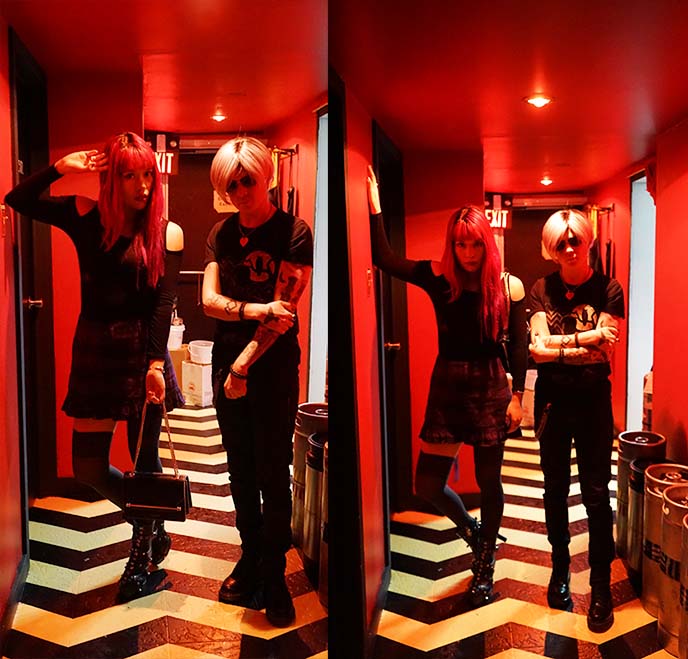
In the story, special agent Dale Cooper learns that the Ghostwood Forest holds the entrance to two extra-dimensional realms: The Black Lodge (a place of evil) and White Lodge (a place of goodness). Rob and I love how the restaurant is named after the dark, Gothic dimension.
The TV show’s lodges are connected by a room with zigzag black and white floors, red curtains, and bright spotlights. As you can see, the restaurant’s bathroom and hallway look just like the Twin Peaks Red Room!

The Black Lodge’s owners, Brad MacKinnon and Claire Wyrostok, are independent business owners who truly put their passion into their restaurants. Brad and Claire adore Twin Peaks, and when they got city approval for the restaurant’s name, the theme took on a life of its own.
Today, Peakers (hardcore fans) even make Lynchian pilgrimages up from California, to see the show’s Pacific Northwest shooting locations and visit this bar.
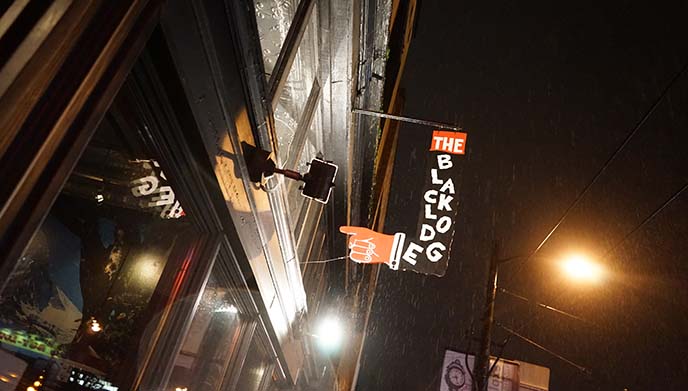
Outside the new location, you can see The Black Lodge sign beckoning mysteriously.
The atmosphere recalls the words of Deputy Hawk: “There is a legend of a place called the Black Lodge… every spirit must pass through there on the way to perfection. There, you will meet your own shadow self… But it is said, if you confront the Black Lodge with imperfect courage, it will utterly annihilate your soul.”

Rob was amply prepared to cross the dark threshold, with his custom ring and tattoos featuring the Twin Peaks sigil! He’s also wearing a t-shirt based on the series, which you can see in the image below.
The Black Lodge has an extensive food and drinks menu. We eyed the list of over a dozen special cocktails, all named after Twin Peaks references.
Above, Rob is holding a “Blue Rose” mixed with Beefeater gin, curacao and Aquafava. On the left is Ben’s “Double R” — coffee infused genever and sherry. Indeed, it was a “damn good coffee,” “black as midnight on a moonless night!”
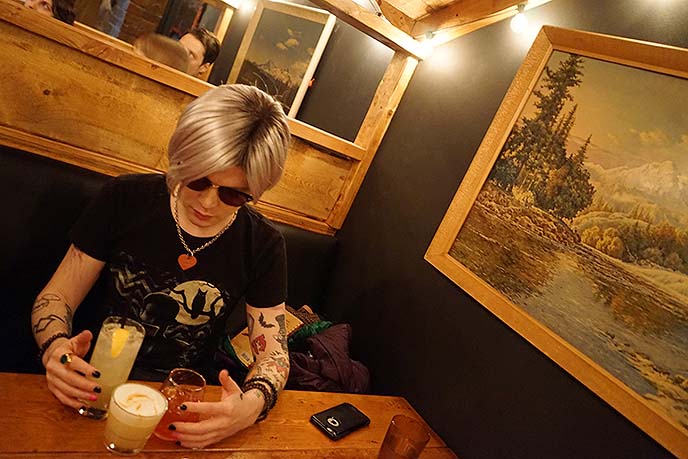
I prefer drinks on the smokier, not-sweet, “old man” side. My personal favorites were the “Fire in the Mill” (rosemary gin, scotch, ginger, lemon, bitters), “Wally Brando” (brandy, chartreuse and grenadine), and “Ghostwood Forest” (infused gin and tonic with muddled rosemary).
For something on the sweeter side, try the outstanding Lynch-burg Lemonade on the left (triple sec, Jack Daniel’s and mint).

The Black Lodge serves hearty comfort food, all of it vegan or vegetarian. I tried the B.A.L.T sandwich, and it was melt-in-your-mouth delicious. The “bacon” is house-made with coconut, and I couldn’t tell it from the real deal. Paired with avocado, sprouts, tomato, cheddar, dijon and garlic aioli… it was creamy crunchy heaven.
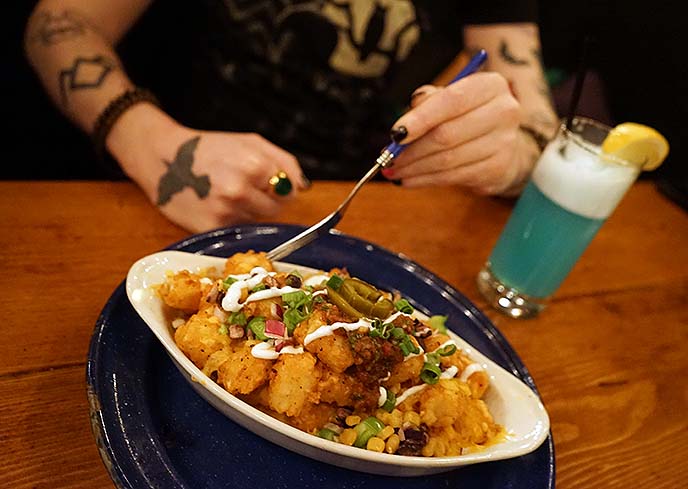
There are many indulgent dishes that you can share, including curry poutine, nachos, vegan drumsticks.
In Twin Peaks, inhabitants of the Lodge feasted on garmonbozia — which looks like creamed corn, but is made up of pain and sorrow. While this isn’t on the menu, a similar-looking “Tot-Chos” is available (above): spuds smothered in corn, beans, salsa, jalapenos, sour cream and cheddar. We ate it up like it was the nectar of the undead!

If you’re in Vancouver, Canada, there’s no better place to spend a spooky night with friends than The Black Lodge. (All photos by Ben and La Carmina.)
My black cut-away top is by Michi; more from this avantgarde activewear label below:

That night, we made a toast in memory of our friend Rose (June 26 1988- January 11 2017). Can’t believe it has almost been a year since we went to her memorial in Sechelt.
Rob introduced Rose to the original Twin Peaks, and she devoured each episode. She always had a blast dressing up and going to underground, off-the-beaten path places with us. Rose would have adored The Black Lodge (I even had old photos of her in what look like a Red Room), and it certainly felt like she was there with us.
We’ll try to keep the tradition going and meet up every year around this time, to celebrate her life.
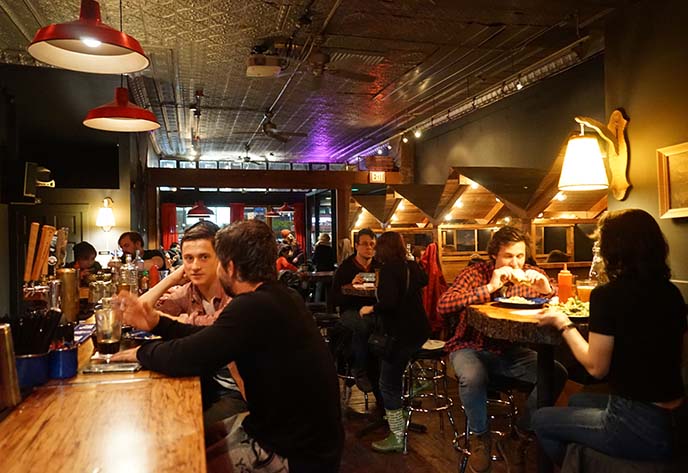
The Black Lodge fills up fast on weekends, so I encourage you to come early and nab one of the peaked booths. Weekdays are no problem.
Even if you know nothing about Twin Peaks, the restaurant / bar has a warm, easygoing, Canadian cabin feeling that anyone can enjoy.
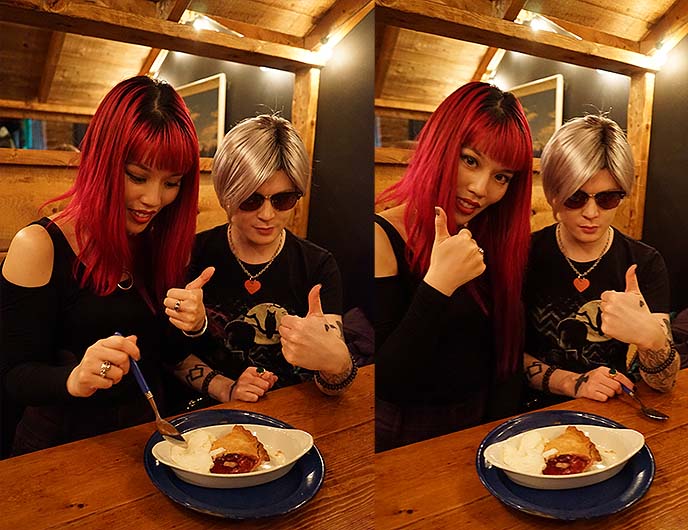
As detective Dale Cooper would say, “If you ever get up this way, that cherry pie is worth a stop.” The Black Lodge’s “Damn Fine Cherry Pie” is a fresh-baked slice filled with tart fruit, served warm and with a scoop of vanilla ice cream. Two thumbs up!

The bar has a large selection of spirits, and various beers on tap. Go for the Black Lodge Lager, an amber-style Baltic brew. (Note that the restaurant’s font and logo are reminiscent of the one on the Twin Peaks map.)
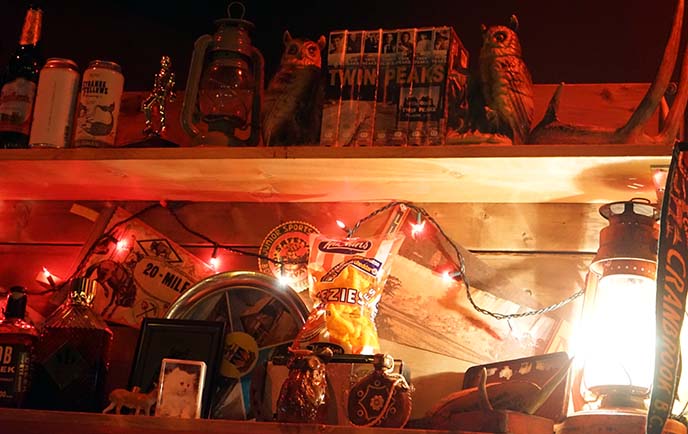
The owners Claire and Brad are lovely, and put genuine care into the service and decor. I smiled when I saw a VHS Twin Peaks collection, guarded by owls. Below, there’s as tribute to Canadiana kitsch; those “Cheezies” are our national version of Cheetos.
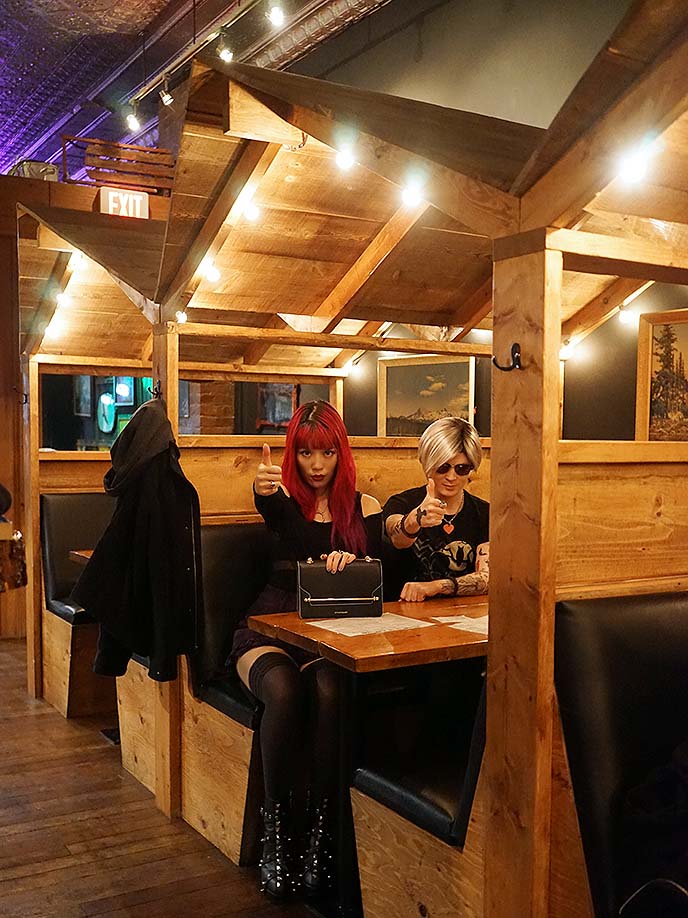
The Black Lodge restaurant gets an earnest thumbs up from all of us! If you’re in Vancouver, Canada, do check out their newly established Broadway location.
My outfit details: Spiked boots by Tripp NYC, Wolford hold-up socks from UK Tights, purse by Strathberry.

“The Owls are not what they seem…” But “Where we’re from, the birds sing a pretty song, and there’s always music in the air.” (Twin Peaks quotes)
For more info, check out the The Black Lodge website that includes opening hours, menus, addresses etc.
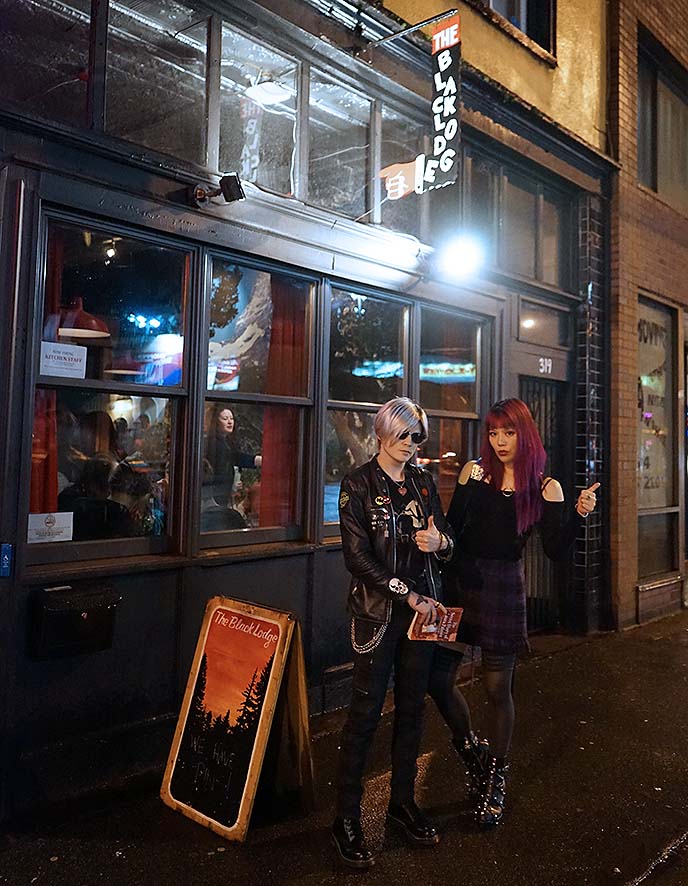
I dressed a bit like Audrey Horne for our Twin Peaks dinner. Played by Sherilyn Fenn, she’s the daughter of a wealthy businessman and enamored with FBI Special Agent Cooper. I wore red lipstick, a plaid skirt and deadly heels in her honor.
OOTD: Thigh high socks from UK Tights; they’re these Wolford Velvet De Luxe Holdups. My top is by Michi and I’m wearing a plaid skirt similar to this. Boots by Tripp NYC.

I completed the outfit with my new Strathberry purse. They just released this East/West – Black with Edge bag… isn’t it a beauty? It arrived in a beautiful black box with gold font, and matching dust bag.
The 2018 East/West has the brand’s signature structured silhouette, branded hardware, and bar closure.

Strathberry’s East / West dual-length strap is an ingenious design. You can extend one end and wear it cross-body… or double it up, and sling it over your shoulder! The gold chain is beautiful quality and easy to adjust, yet the bag is lightweight.

All of their handbags are made in Spain with the finest calf leather, and lined with a suede-like microfiber. The flap has an easy yet secure closure: you slip it under the horizontal bar, and it secures magnetically.
I also have the Strathberry midi tote, from their original collection. You can find this style below:

I’m quite choosy about handbags, and the popular luxury labels don’t appeal to me (no monograms please!).
On the other hand, Strathberry is an independent, artisan company based in Edinburgh. Their purses have clean lines and exquisite luxury detailing, which appeal to my love of minimalism, and increasing focus on “slow fashion” over mass production.

Here’s a peek inside my East/West White Edge purse. There are two compartments with one interior pocket, and the accordion-style sides can expand. It’s the perfect size for me: compact, yet spacious enough to hold all my necessities.

Strathberry just released multiple new designs for 2018, and I couldn’t be happier with their East/West crossbody meets shoulder bag! The purse comes in various colors and combinations, and there’s a mini size as well.
Are you loving Strathberry as much as I am? I hope you enjoyed these photos, and the tour of the Twin Peaks themed diner.
(PS: see below for more about this sweet bag.)



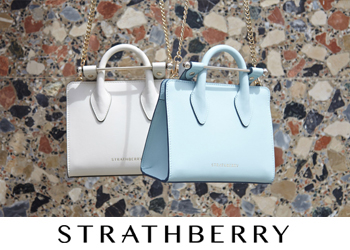
 LA CARMINA
LA CARMINA






